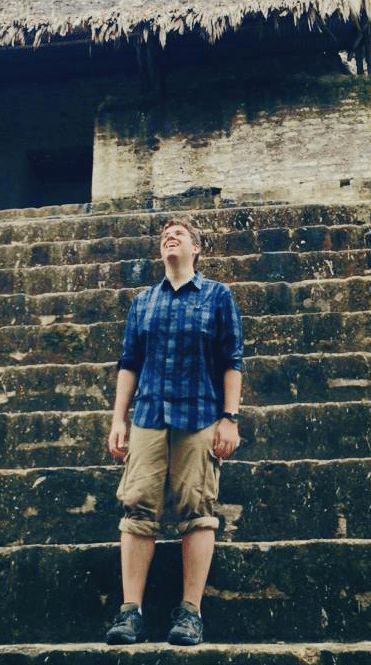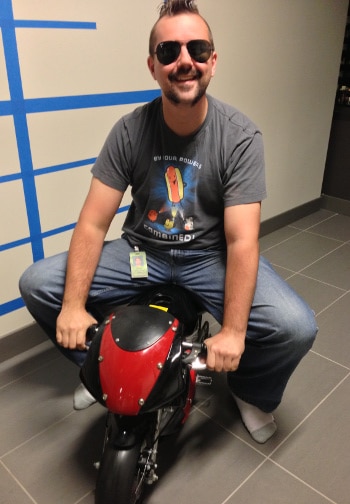Mark didn’t put together a PowerPoint deck. He didn’t bring a spreadsheet. He didn’t bother thinking up an elaborate pitch. That’s not how game developers work. And it’s not how we work.
So when the intense, dark-eyed senior technical evangelist dropped by Valve’s Seattle headquarters in July 2013 to suggest the game developer try something radical with two of its most storied titles, Mark just tossed his SHIELD to a member of Valve’s engineering team.
Mark had brought Valve something that’s long been a passion project for our engineers. We’d been working hard to put Valve’s games onto our mobile chip. Now Mark had “Half -Life 2″ and “Portal,” two of the best PC games of all time, on our SHIELD portable gaming device.
Members of Valve’s team grabbed the silver-and-black SHIELD and started playing. Mark knew the only way to get Valve on board would be to show them something great. “Well, this is cool,” one said after a few minutes. “We’re going to have to talk about this.”
In the Game

This is a tale of what happens when a passion for gaming intersects with the power of the latest portable devices. It’s also an example of how closely our engineers collaborate with the companies at the cutting-edge of gaming. And how they’re building a new generation of open-source tools that make it easier than ever to move those experiences to mobile devices.
There’s a long back story here. Like many stories at NVIDIA, it’s one that begins with our team of developer technology specialists. Think of them as the A-Team. Specialists with an eclectic array of capabilities drop in — sometimes for months — to help game developers get through sticky technical problems. Then, they move on to help another developer make the most of what our GPUs can do.
And when the motley members of that team work together, the results can be amazing. Putting these games on Android took the talents of more than a dozen of our best engineers. They include Seth, a smart, funny self-described “compilational path-magician,” with a knack for OpenGL. Jeremy, a self-effacing GPU architect who colleagues say can wring 2 or 3x performance gains out of thin air.
And James, a six-foot-five senior software engineer who can quote dialogue from Portal by heart (one of his favorite quotes: “The Enrichment Center once again reminds you that android hell is a real place where you will be sent at the first sign of defiance”).
Because we work so closely with Valve, James has access to code for Valve’s games. And, like his colleagues at Valve, James is immersed in Linux. He even cranks out his code on a Linux-powered workstation tricked out for speed with solid-state hard drives and 32 GB of RAM.
Power Tools
To put Valve’s games on Android, James turned to a group at NVIDIA working on an open source project — REGAL – that lets developers move code built for PCs using OpenGL – a standard that helps developers quickly add cutting-edge graphics to their game — to mobile devices that rely on a special version of OpenGL known as OpenGL ES 2. The target for this technology: devices running Tegra 4.

The efficient, powerful mobile processor NVIDIA cranks out the kind of power that could only be found on desktop machines a few years ago, using just a fraction of the power. Seth was already working on a Linux for Tegra port. That work helped lead to our Jetson Tegra K1 developer kit. And Seth remains an evangelist for Linux on Tegra.
So James teamed up with Seth and Cass — both experts in the OpenGL graphics standard — to demonstrate that power. The result: they turned to their favorite games. James estimates he’s played thousands of hours of Portal and Half- Life 2.
The result was a five-minute demo at Valve’s offices that was anything but unpolished. By the time Valve’s engineers put the controller down, all the work poured into REGAL and OpenGL, and all the intimate knowledge of Valve’s content started paying off. But Valve’s engineers saw enough to let James and three other engineers keep working.
Word quickly got around. Soon one marketing executive — an inveterate Half Life 2 fanboy — took it upon himself to spend hours ‘QA’ing’ their work. A Half- Life 2 obsessive, he quickly found bugs no one else had yet found. That level of polish paid off.
In March, we took the covers off. NVIDIA announced Portal would be coming to SHIELD. But rather than setting off a last moment scramble, James and his team found that building a gaming experience strong enough to impress Valve meant most of the work was done. The biggest bug: one quality assurance tester found that turning on the flashlight in Half- Life 2 slowed gaming performance. After a quick patch, the game was done.

‘Perfect Port’
It wasn’t until launch day that we announced we were bringing Half -Life 2 to SHIELD, too. The response went beyond just a wave of publicity. Half- Life 2 and Portal are now two of the top rated games on the Google Play Android app store. 89% of those rating Half -Life 2 on Google Play gave it five out of five stars. Portal grabbed even stronger reviews: with more than 9 out of ten giving the game five stars. “Perfect port,” wrote one user. “One of the best games ever now playable on the Shield.”
Most of the credit, of course, belongs to Valve. They built the game. We just made it portable.
- See more at: http://blogs.nvidia.com/blog/2014/06/26/portal-half-life-2-shield/#sthash.uU9KbGmQ.dpuf

 O-Sense
O-Sense







.png)

